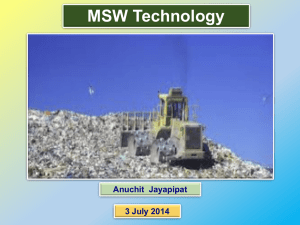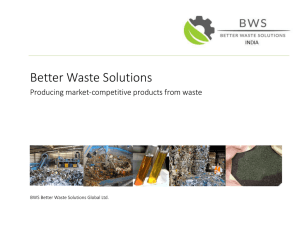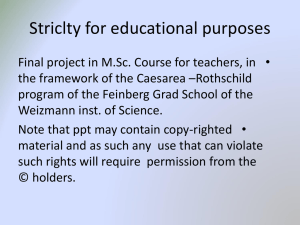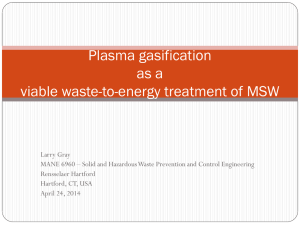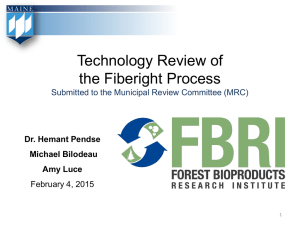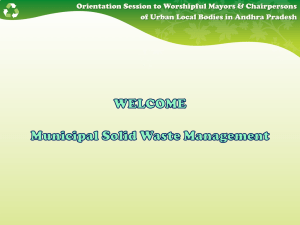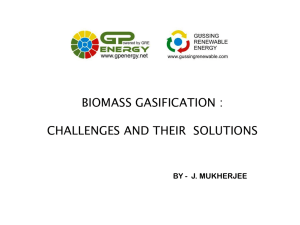Clean Energy City or Multi-Faceted Eco-Friendly
advertisement
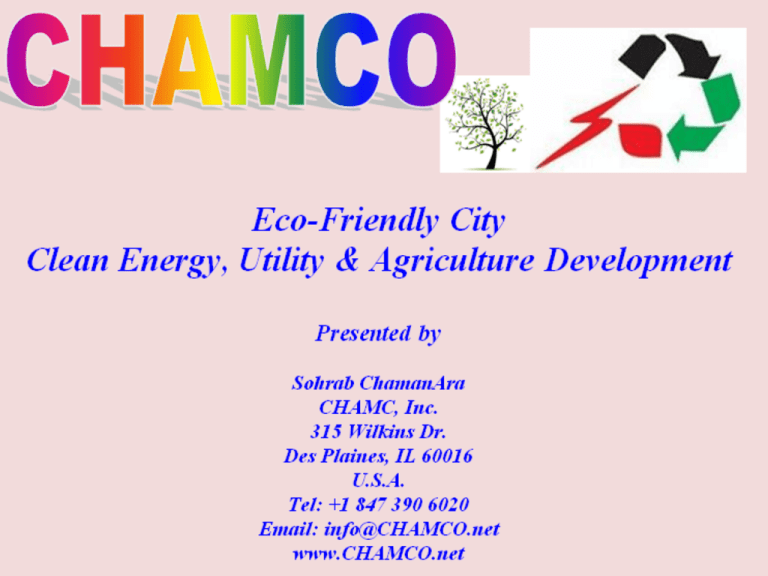
SS INTRODUCTION A multifaceted project for infrastructure development in a Country or for Development of an eco-friendly city THE PROJECT ELUCIDATES THE USES OF MUNICIPAL SOLID WASTES (MSW) To produce Electricity, Fertilizer and Compost Electricity from Wind and Sun Underground Geo-thermal Geo-Vision Exploration for water Desalination of salty water Gas and Electricity from Sewer Bio-fuel from Algae Fuel from Waste Tire Agriculture development …CONTD… Municipal Solid Waste (MSW) is the primary hazard to the environment and people of any community. However, MSW is a bio-mass and could be used as fuel to generate electricity or to be converted into compost or fertilizer. In this multifaceted proposal, the primary emphasizes is to make use of MSW in the most environmentally friendly way to produce electricity, compost and fertilizer. GENERATION OF ELECTRICITY FROM MSW: This is done in three stages: Making Briquettes; by Sorting- Automatically & manually both, drying & shredding MSW. Gasification: Thermal cracking of fuel (briquettes) at a high temp. of 1050o C to 1100o C in the minimal presence of Oxygen to produce Synthesis Gas or SynGas with a composition of CO:26to30%, H2:26to30%, CH4:11%, CO2:6 to 8%, N2:8to10%, with a Calorific value >2000 Kilo Calories /cubic meter whilst the Cal. Val. of Natural Gas is 8500Kcal/m3 Electric Generation: By injecting Syn-Gas directly into a gas engine generator, which has been modified exclusively by us to operate with Syn-Gas. 1. MAKING BRIQUETTES GASIFICATION: Gasification is a reliable clean energy technology that can turn a variety of low value feedstock into highly valuable energy which can be put to use for Thermal uses in Furnaces in Steel Mills, Brick Kilns, Dryers or Boilers for generating Steam for Green House heating, other Industrial use, other Heat treatment equipment OR for Power Generation as a Clean & an alternative source of Electricity. Gasification, a Worldwide accepted process for Renewable energy, receiving backing & subsidies from various Governments the world over, has been reliably used on a commercial scale for more than 50 years, all over the World, in the refining, fertilizer, and chemical industries, and for more than 35 years, with primitive technologies, in the generation of electricity. Our Multi-fuel Gasification System can utilize any type of biomass including MSW, coal, waste wood, sawdust, furniture scraps, bagasse, rice husk, coconut shells, poultry litter, plastic, rubber, tires, or any other combustible material. Ultra clean gas is fed into the engines through microprocessor based actuator type governors GASIFICATION PROCESS PROCESS STEPS Feedstock is fed at the top and descends through gases rising in the reactor. In the upper zone a drying process occurs, below which pyrolysis is taking place. Following this, the material passes through a reduction zone (gasification) and in the zone above the grate, an oxidation process is carried out. Air combined with steam is supplied at the bottom of the reactor. Combustible gas at a temperature of close to 400o C.(Gas temp. reduced because of the evaporation of moisture in the drying zone) is discharged at the top of the reactor, and inert ash from the heat-generating oxidation process comes out from the reactor bottom through a water lock & falls down on an auger by means of a scraper fixed on the outer side of the chamber in the Ash pan. ….CONTD…. Co-Generation: The exhaust emissions of the engine can be used for a low pressure Waste Heat Recovery Boiler. 1 ton Steam at 7kg. Pressure per MW per hr. can be obtained & can be put to use for other thermal applications. In a coal gasification, our coal gasifier consumes 418 Kg coal with 6000 Kcal/Kg caloric value to produce 1 MWH. Therefore 1 MW coal gasification power plant requires 10 Tons of coal / day. Since the caloric value of MSW Briquettes is assumed to be 3000 Kcal/Kg, therefore: 4 MW MSW gasification power plant needs about 80 Tons of MSW Briquettes / day. PROCESS STEPS Sized fuel is lifted and delivered to the storage hopper above reactor assembly by skip-hoist / Bucket-Elevator / Belt conveyor. From the storage hopper, fuel is fed to the reactor through double-bell cone fuel feeding system to prevent leakage of Gas. Feedstock travels downwards and is dried and preheated. Thereafter it undergoes thermal cracking at high temp. of 1100deg.C through different thermochemical processes to produce Producer/Syn- Gas coming out from the top of the Reactor at a temp. of close to 400deg.C. On coming out of the reactor, the Producer gas is passed through two stage Venturi Cyclones where the gas is cooled and cleaned of particulate impurities. ….CONTD…. Then, the Producer gas is passed through multi-stage Pipe shower filters for cooling to ambient temperature and further washing of particulate impurities. This Producer gas at ambient temp. is injected into TAR & Dust separators for segregation of TAR, which is received as a by-product. This clean gas is passed through a de-moisturizer for drying. This dry & ultra-clean gas is monitored for dryness by a Humidity analyzer and for composition by an On-line Gas analyzer. This Ultra-clean and dry Gas at the outlet, through Gas control valves is ready for injection into a Kiln for Ceramic Industry or a Generating set modified by us for Producer gas mode of operation. CATERPILLAR NATURAL GAS GEN-SETS CAT NATURAL GAS GEN-SETS FERTILIZER FROM MSW SCHEMATIC FOR A COMPACT UNIT FOR SMALL SCALE COMPOST & FERTILIZER PRODUCTION. CONVENTIONAL WAY FOR FERTILIZER, USING MODERN EQUIP. & TECHNOLOGY: MSW SORTED INTO SEPARATE COMPONENTS: RENEWABLE ENERGY ALTERNATIVES: SUN & WIND GEO-VISION EXPLORATION FOR WATER & DESALINATION OF SALTY WATER ….CONTD…. FUEL FROM ALGAE HARVESTING ALGAE WE PROPOSE TO CONVERT SEWER INTO AN ANAEROBIC DIGESTER FOR A BIG COMMUNITY OR FEW HOMES Biogas is a fuel gas made from biomass such as feces, food waste, grass and straw etc. by the anaerobic fermentation process. Biogas contains about 55% - 70% methane (CH4), and some carbon dioxide, some water, some hydrogen some carbon monoxide and some hydrogen sulfide (H2S). The heat value of biogas is 5142 Kcal/m3 Conditions required for biogas production: Strict absence of Oxygen. Temp. between 8 to 65 Deg.C. The higher the temperature, the more the activity of bacteria resulting in higher biogas production. Neutral or slightly Alkaline environment, a pH value between 6.8 and 7.5 ….CONTD…. For a 10 m3 biogas plant to keep a 5 m3/day biogas production, 150 kg cow dung or 110 kg pig dung is needed daily. The liquid from biogas plant can be recycled. Biogas residue are good organic fertilizers. Raw material needed to produce 1 cubic meter biogas: Cow Manure 5.26 kg dry = 30.96 kg fresh Chicken Manure 4 kg dry = 13.34 kg fresh Human Manure 3.33 kg dry = 16.67 kg fresh BIO-GAS PLANT RECYCLING OF USED TIRES The semi-continuous pyrolysis system is designed to get rid of the Tire shredding process. Features: Automatic feeding, automatic slag on the basis of batch style pyrolysis process. It saves the fuel for heating & operation time for each batch & boosts the batch pyrolysis efficiency. This technique uses a special mechanism to heat the used tires in a closed stove to melt down the tire to produce Tire Oil & Carbon Black. Capacity: Up to 24Tons/day. LAY OUT OF TIRE TO OIL PLANT: AN INSTALLED TIRE TO OIL PLANT DRIWATER & PERMACULTURE Rehabilitation of Land or Landscaping Revegetation Erosion Control Forestry Before starting this agricultural task, a survey of the area is needed and experts who have done similar projects will be employed. Two methods, so far, have been found, which successfully planted trees in Australia, Egypt, Tunisia and Saudi Arabia. First is DRiWater & Second is Permaculture DRIWATER PERMACULTURE ….CONTD…. FEW TREES RESEARCHED FOR THIS PROJECT ….CONTD….
